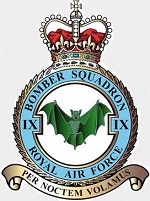Hobby Master HA6702 RAF Panavia GR. Mk. 1 Tornado IDS All-Weather Bomber - ZA 592"G", No.9 Squadron, RAF Honington, England, 1983 (1:72 Scale)
"Per noctem volamus ('We fly through the night')"
- Motto of No.9 Squadron
 During the late 1960's a number of European countries examined ways to replace their existing fleet of combat aircraft using next-generation design techniques. Several countries looked at variable geometry wing configurations as a means of making a plane perform well throughout a wider flight envelope. Variable geometry allows the pilot and/or fly by wire system to adapt the aircraft's wing shape to the optimal settings dependent on its height, speed, and load. The Tornado takes this one step further and incorporates swiveling weapons pylons that always ensure the stores are parallel to the airframe, thus minimizing drag and improving airflow across the entire surface of the aircraft especially at low altitudes.
During the late 1960's a number of European countries examined ways to replace their existing fleet of combat aircraft using next-generation design techniques. Several countries looked at variable geometry wing configurations as a means of making a plane perform well throughout a wider flight envelope. Variable geometry allows the pilot and/or fly by wire system to adapt the aircraft's wing shape to the optimal settings dependent on its height, speed, and load. The Tornado takes this one step further and incorporates swiveling weapons pylons that always ensure the stores are parallel to the airframe, thus minimizing drag and improving airflow across the entire surface of the aircraft especially at low altitudes.
Britain and France joined forces on a variable geometry aircraft project, called the Anglo French Variable Geometry (AFVG) project. France was already in the process of developing a variable geometry airframe of its own. In 1968, Germany, Holland, Belgium, Italy, and Canada formed a working group to look at replacements for the aging F-104. The outcome was initially called the Multi-Role Aircraft (MRA) project, which was later changed to the Multi-Role Combat Aircraft (MCRA). Britain later joined this group on the strength of its variable geometry design.
Pictured here is a stunning 1:72 scale diecast replica of a RAF Panavia GR. Mk. 1 Tornado IDS all-weather bomber that was attached to No.9 Squadron, then deployed to RAF Honington, England, during 1983.
Now in stock!
Dimensions:
Wingspan: 7-3/4-inches
Length: 9-1/4-inches
Release Date: September 2020
 Historical Account: "We Fly Through the Night" - Number 9 Squadron (otherwise known as No.IX (Bomber) Squadron or No.IX (B) Squadron) is the oldest dedicated Bomber Squadron of the Royal Air Force. Formed in December 1914, it saw service throughout the First World War, including at the Somme and Passchendaele. During the Second World War, No.IX (B) Squadron was one of two Avro Lancaster units specializing in heavy precision bombing (the other was No.617 Squadron) and sank the battleship Tirpitz on November 12th, 1944, in Operation Catechism.
Historical Account: "We Fly Through the Night" - Number 9 Squadron (otherwise known as No.IX (Bomber) Squadron or No.IX (B) Squadron) is the oldest dedicated Bomber Squadron of the Royal Air Force. Formed in December 1914, it saw service throughout the First World War, including at the Somme and Passchendaele. During the Second World War, No.IX (B) Squadron was one of two Avro Lancaster units specializing in heavy precision bombing (the other was No.617 Squadron) and sank the battleship Tirpitz on November 12th, 1944, in Operation Catechism.
Between 1962 and April 1982, the Squadron flew the Avro Vulcan B.2 as part of the V-Force. In June 1982, it became the first front-line squadron in the world to operate the Panavia Tornado GR.1. In May 1998, No.IX (B) Squadron received the RAF's first Tornado GR.4, which it operated until reequipping with the Eurofighter Typhoon FGR.4 at its present home base of RAF Lossiemouth on April 1st, 2019.


